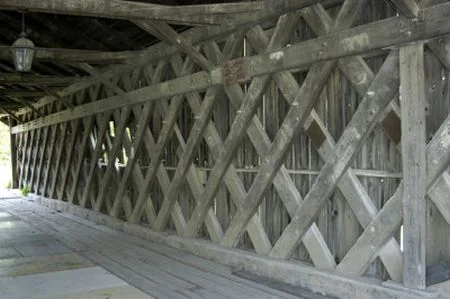Covered Bridges within 8 miles :
Holmes Covered Bridge, Charlotte beach
The Mt. Philo Inn is within 8 miles of 5 historic covered bridges. Drive to the rivers, museums and lakesides where they live in completely picturesque locations
Why cover bridges?
The covering protected the wooden floorboards from rot. Horses don't like to cross open bridges where they can see and hear the rushing water. The bridges were covered and, you will notice, the entrances look like that of a barn. The horses would enter willingly. Snow clearing was safer and easier. These well-built distinctive crossings, were handmade with huge timbers. Because they serve to link a community, they are a much-loved part of the New England landscape.
Quinlan covered bridge, Lewis Creek, Charlotte
3 of the 5 nearby bridges still carry traffic, providing motorists with a brief "back in time" experience.
The Holmes Creek Covered Bridge, also called the Lakeshore Covered Bridge, is a one-lane wooden covered bridge that crosses Holmes Creek in Charlotte on Lake Road, adjacent to Charlotte Beach. Park at the beach and step back in time while enjoying a great view of the broad lake.
Sequin Covered Bridge, Charlotte, Vermont, Lewis Creek
The Quinlan Bridge, 2 mi. or lower bridge, crosses the Lewis Creek along Spear St. in Charlotte. It was built in 1849 and rebuilt in 2014 due to structural problems. Read all about it here
The 58-foot-long Seguin Bridge, 6 mi. or Upper Bridge is a Kingpost Burr Arch was built circa 1870 to span the Lewis Creek on Roscoe Road in Charlotte. Named for a family which once owned much of the land around here. The alias "Upper" is because it is the upstream of two covered bridges on Lewis Creek.
Spade Farm, Starry Night Cafe, Vermont Flannel
The Spade Farm Covered Bridge, 3 mi., also called the Old Hollow Covered Bridge, previously crossed the Lewis Creek just 1 mile to our south. It now sits next to our favorite restaurant, Starry Night Cafe, on Route 7 in Ferrisburgh. Grab a beer and have a stroll.
Built in 1845, the Museum Covered Bridge 8 mi. originally spanned the Lamoille River in Cambridge, Vermont. The trusses for the double bridge were assembled in a field next to the chosen site. Measuring 168 feet in length, with two vehicle lanes and a footpath (attached after its original construction), it is an impressive example of the engineering principles and bridge-builder's craft practiced during the 19th century.
Museum Covered Bridge, Shelburne Museum, Shelburne Vermont
The bridge was lighted by kerosene lamps.
During the 1927 Flood the water rose seven feet above its floor.
The bridge replaced a ferry that existed in its place before, connecting two neighborhoods of Cambridge, Vermont
“In the late 1940s, Electra Havemeyer Webb of Shelburne Museum, sought to preserve early American life and asked the VT Highway Department to help find a bridge worth preserving. When it was learned that the "Big Bridge" (as it was known at the time) was to be replaced, this "double-barreled" bridge with its walkway was too much to resist. The Museum dismantled the Covered Bridge in 1949 and moved it to the Museum grounds. The beams still bear the identifying numbers for reconstruction. By situating it above a man-made pond, extensive landscaping integrated the bridge into the grounds. The Covered Bridge served for many years as the Museum's entrance, but when automobile traffic proved too taxing, the Museum relocated the entrance and retired the bridge from duty.”






